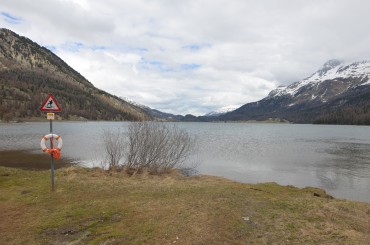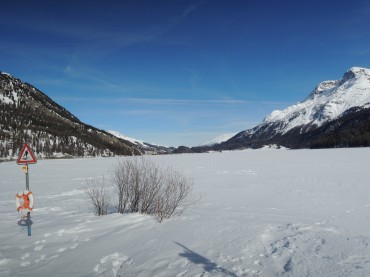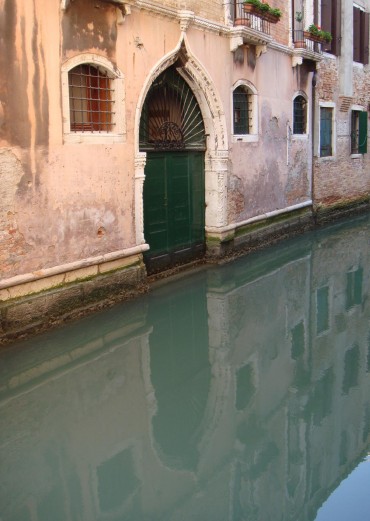

Lake of Silvaplana in summer and winter time Photos: Cecilia Obiol

Venice: the Unattainable, Kathrin Haltiner, contribution to the “un-Commen Venice“ by Günther Vogt, 13th Architecture Biennale
16.7.2014 – Issue 13 - Water – Hotz Anna, Vogt Günther – Videos, Studio, Interviews
Water and Landscape
Interview with Günther Vogt
GV First of all, I think we have to recognise that architecture and landscape
architecture always deal with culture. This means that we only see
what we know. Without knowledge, you cannot perceive or value the
landscape. In this way, architecture and landscape are similar. Here,
of course, we are referring to culture and to specific cultures, which is
particularly apparent in Switzerland, in the Alpine region, where there
are different types of architecture and landscape. The Wallis canton has
spread-out villages, built on the slopes of the landscape, and it becomes
more and more specific the higher up you go.
Perhaps because we live mainly out of the water, it is regarded as the
real natural element. As of its perception, we always see people looking
at, feeling, touching water; it is a global sign of nature. The water in Engadin
is very special, mostly because it completely changes from winter to
summer. In summer, you have a regular landscape of small lakes—quite
a Romantic landscape, which the English loved for its picture-postcard
appeal. Then, in winter, the lakes are large, everything is white and almost
like an urban plaza, because you can walk on the frozen lakes, like Jesus.
In practical terms, we first of all try to deal with rainwater, making
sure that rather than disappearing into the sewerage system, it returns to
the landscape, not just for irrigation, but to the ground, for the processes
of the landscape’s natural system. In the urban situation, we try not to
waste water. Nowadays, water is privatised, and the younger generation
carries around water in their rucksacks; they pay for it, which changes it in
a political sense. We always try to make water available for free, because
you can survive for some weeks without eating but not without drinking. In
this sense, water today is super politicised; it is the gold of the future. It is
already apparent that energy and oil crises are not such big issues—the
real problem will be water. For instance, in the Middle East they have oil,
so they have the energy to desalinise seawater, which means it is less of
a problem. But it will be increasingly problematic, especially in countries
like Switzerland, which is known as the water castle of Europe; even here,
in the recent past there have been problems providing enough drinking
water. The knowledge that we are running out of water is more pressing
in Middle European countries such as Germany and Switzerland. I don’t
know why it is a significant problem—we transport drinking water across
the oceans, packed in huge bags; California buys water from Canada.
Everyone can see it, but somehow it’s not up for discussion.
In the cities of the past, fire was the most dangerous element, but
now water is much more dangerous because of problems of floods and rising
seas, which we cannot control. For an exhibition I had at the Art
Museum in Bregenz, I wrote on the invitation card: “Museum flooded,
about 50 cm in water.” Everybody asked why I put a natural catastrophe
on the invitation. I said because it is not a natural catastrophe; it’s new
and it’s man-made. We build surfaces with asphalt and concrete, which
causes water to flow much faster into cities and, at the same time, the
authorities are spending lots of money to protect us against this water. It
is a two-edged problem: on the one hand, water is really needed and we
are running out of it; on the other hand, we sometimes have much too
much. That’s really controversial.
AH Water, as changeable as Proteus, has many sides to it. From being
weak and calm, it can, when frozen, become strong enough to split
stone. Do you try to express these ambiguous qualities?
GV At the last Biennale, “Common Ground,” we tried to explain Venice
through water. Musil wrote a wonderful fiction called The Man Without
Qualities; you could say that water has no character. It’s shapeless, it
doesn’t smell, it’s autonomous—it has no character. Then, of course, you
can also shape it—ice, fog—and with all that add colour to architecture.
That’s why it’s so interesting as an aesthetic element, because it does
not have its own character. But you can always add to and transform it.
This change in perception relates to the season, which is very interesting,
especially at the small scale. We have big projects where we have to deal
with water in a very substantial way: groundwater, digging into the ground,
subsequent flow, and so on. At the large scale, it is more about processes;
at the small scale, it’s more about aesthetics. Ultimately, however, I
think landscape architecture should focus more on water and rainwater
management—how we deal with water ecologically.
Interview with Anna Hotz
Download article as PDF

